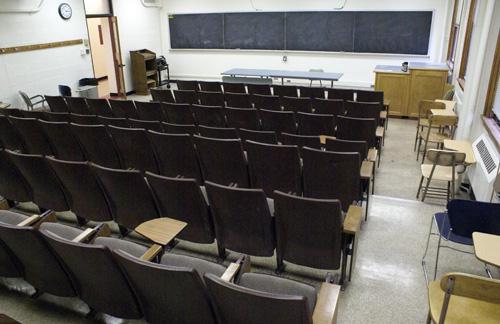Over 100 projects ahead for Deferred Maintenance

This first floor classroom of Altgeld Hall has recently been remodeled; however, the other floors have yet to be touched. Erica Magda
February 7, 2008
With an aging campus, building maintenance becomes increasingly important, and Facilities and Services is working to keep up with all of the various projects.
There are more than 100 projects on the budget for construction and planning for Deferred Maintenance at the University, according to the University’s Web site. The focus of Deferred Maintenance projects is to address energy conservation, life safety, mechanical systems and other general maintenance issues, said Doris Reeser, capital maintenance planning coordinator for Facilities and Services.
The projects Deferred Maintenance works on are selected using an outside firm which reviewed all the buildings on campus, Reeser said. However, she said the majority of these projects are in the planning stage.
“They made a list for each building for the deferred maintenances,” she said. “They then prioritized those lists.”
The last time the building review firm was at the University was in 2006, and they are expected to come again this year, Reeser added.
Get The Daily Illini in your inbox!
Money for the projects submitted comes from three sources: the Academic Facilities Maintenance Fund Assessment, Certificates of Participation and the University Administration Fund.
The Academic Facilities Maintenance Fund Assessment is a $250 per semester nonrefundable student fee that was instituted in fiscal year 2007. The fee applies to full-time graduate and undergraduate students who entered the University during that fiscal year. It will be phased in over four years so that by 2010 all full-time University students will be paying.
The Certificates of Participation is money the University borrowed to get a jump start on maintenance and is the largest source of funding this year, with $30 million for this campus, Reeser said.
The University Administration Fund is available every fiscal year and is approximately $5.5 million for 2008, she added.
Deferred Maintenance uses multiple sources to choose what needs to be changed to improve energy use.
Students work with the department to find ways to address buildings’ energy efficiency.
“We use a modeling software called Trace,” said Stephen Capela, a graduate student. “I input various kinds of data into the software, and it takes into account the area square footage, what the walls are made of and any information that would provide insight on heat transfer and energy information.”
The department also uses Terry Ruprecht, director of energy conservation, as an adviser for energy conservation related projects.
“We know, ordinately, which buildings consume the most energy.” Ruprecht said. “We have about 160 major buildings, but about 31 of these buildings use 60 percent of the campus energy. We tend to look at the high consumers first.”
As projects get done, monthly meter readings are completed to gauge how much energy was saved by the changes made, Ruprecht said.
The University’s Retro-Commissioning group, which is made up of employees, reviews buildings to see if they are operating as intended.
This is happening now on campus, and the group reviews about one building per month, Reeser said.
“The Retro-Commission Group went through the Krannert Center and affected some changes,” Ruprecht said. “We were seeing some notable electric savings just after a month.”
In December 2005, Krannert Center for the Performing Arts used 466,000 kilowatt-hours of electricity compared to December 2007 when the center used 305,000 kilowatt-hours of electricity.
This is more than one-third of a reduction due to maintenance work, Ruprecht said.
Other projects Deferred Maintenance works on involve fire alarm installations, exit signs and other items related to safety in the event of a fire. These are categorized as Life Safety projects.
“Some buildings have partial fire alarm systems, and some have systems that only notify the fire department,” Reeser said. “We want a system that will notify everyone in the event of a fire.”
One recently completed project includes new classroom renovations in Altgeld Hall.
“Over the winter break about 10 classrooms were renovated in Altgeld Hall using the Academic Facilities Maintenance Fund,” Reeser said “We replaced the flooring and lighting and reframed the windows.”
This project is more visible to students and faculty, whereas many of the other projects are electrical or behind mechanical room doors, Reeser said.
However, not all of the improvements on campus are done by Deferred Maintenance. Sometimes the state will fund a project, which is possible for the case of Lincoln Hall, Reeser said.
Deferred Maintenance will be doing some work in Smith Recital Hall to get ready for the Lincoln Hall renovations.
“We’re getting other auditoriums ready to accommodate classes that Lincoln Hall had been accommodating,” Reeser said.
Much of the construction for these projects will take place over breaks when school is not in session in order to not disrupt classes.






